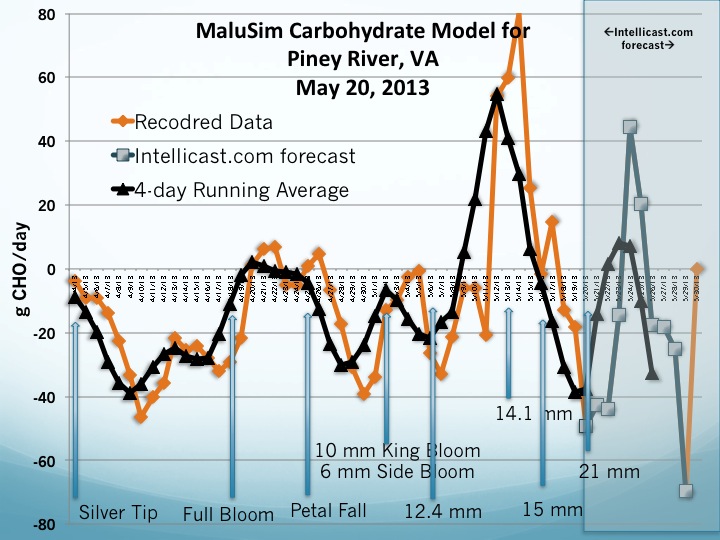Measuring the nutrient needs of orchards should be done by using both soil and leaf (also known as foliar) nutrient analyses. Soil analysis is best done before planting a new orchard so that lime and fertilizers can be incorporated deeper into the soil profile. Adjusting soil pH and getting less mobile nutrients into the rootzone is difficult once the orchard has been established, though there are times when these practices can and should be done. Soil sampling should continue throughout the life of an orchard every five or so years to monitor soil pH. In peach blocks where sulfur has been repeatedly applied for disease control, soil pH should be checked more frequently to ensure that the pH hasn’t fallen out of the acceptable range.
Since soil pH and nutrient content changes through the soil profile, soil samples should be taken from a consistent depth. Many labs will recommend a soil depth to sample, and then use that depth to calculate fertilizer and lime recommendations. The Virginia Tech Soil Lab recommends samples be taken from the top 6-8 inches of soil. When soil sampling prior to planting, it is recommended to take separate top- and sub-soil samples. Additional information on soil sampling can be found in the Virginia Tech Agronomy Handbook.
Soil nutrient analysis is a measure of the “plant available” minerals in the soil. However, due to the complex nature of the soil-root interface, minerals that are “plant available” are not necessarily taken up by plants and therefore soil testing does not always provide an accurate measure of the nutrient status of the trees in the orchard. Additionally, most soil analyses do not directly measure nitrogen content, but instead base nitrogen fertilizer recommendations on soil type and organic matter content. Additional information on soil nutrient analyses for orchards can be found in the following Virginia Tech publications
- Soil Test Note 1: Explanation of Soil Tests
- Soil Test Note 10: Commercial Apple Production
- Soil Test Note 11: Commercial Peach Production
For commercial growers within Virginia, the Virginia Tech Soil Testing Lab conducts soil analyses at no charge. However, there is an additional charge for measurement of soluble salts ($2) and organic matter ($4). For the quickest processing time, be sure to use the official soil sampling boxes. Sample boxes are available from your local Virginia Cooperative Extension office. The Virginia Tech Soil Testing Lab will send you results via email. Please use the most recent submission form when submitting samples.
For mature fruit trees, leaf mineral content is a more accurate measure of the nutrient status than soil analyses. Leaf analysis can help determine if additional fertilizers are needed before there are any visual signs of deficiency in the tree. Leaf samples should be taken when most vegetative growth has subsided (terminal buds are set), which for most bearing apple trees happens in late July or early August. For the most part, by the time leaf samples are taken and analyzed there is little that can be done to impact the current season’s crop and next year’s flower buds. Therefore, to maintain optimal performance of your orchard, it is recommended to perform a leaf analysis for each block once every three years to ensure that you are consistently maintaining adequate nutrient levels.
Below are some additional recommendations for taking accurate leaf samples.
- Collect 60-100 leaves to get a representative sample. Leaves should be taken at about the midpoint of the new growth and from all actively growing parts of smaller trees and between waist and head high on larger trees.
- Choose between 8 and 10 separate trees that are representative of the block.
- Don’t mix leaves from different varieties, rootstocks, ages, soil types, blocks, or farms.
- Sample poorly growing or otherwise problematic trees separately from healthy trees, so that a comparison can be made between them.
Unfortunately, the Virginia Tech Soils Lab does not perform plant tissue analysis. Below is a partial list of regional service labs that perform leaf tissue analysis (this is not an endorsement of these labs and other labs may provide similar services):
1. Penn State Agricultural Analytical Services Laboratory (State College, PA)
- Plant Analysis Kit, $24
- N, P, K, Ca, Mg, Mn, Fe, Cu, B, Zn + crop specific interpretations
2. A&L Eastern Laboratories, Inc. (Richmond, VA)
- PT2 package, $26.20 ($24 without recommendations)
- N, S, P, K, Mg, Ca, Na, Fe, Al, Mn, B, Cu, Zn
3. Agro-One Soils Laboratory (Ithaca, NY)
- Plant Tissue Analysis (#180), $24
- N, P, K, Ca, Mg, Zn, Cu, Fe, B, Mn + recommendations based on Cornell University guidelines
4. North Carolina Dept of Agriculture (Raleigh, NC)
- Plant Tissue Analysis, $25
- N, P, K, Ca, Mg, S, Fe, Mn, Zn, Cu, B + recommendations






 The MaluSim carbohydrate model was run on May 13 for both Winchester and Central Virginia.
The MaluSim carbohydrate model was run on May 13 for both Winchester and Central Virginia.



